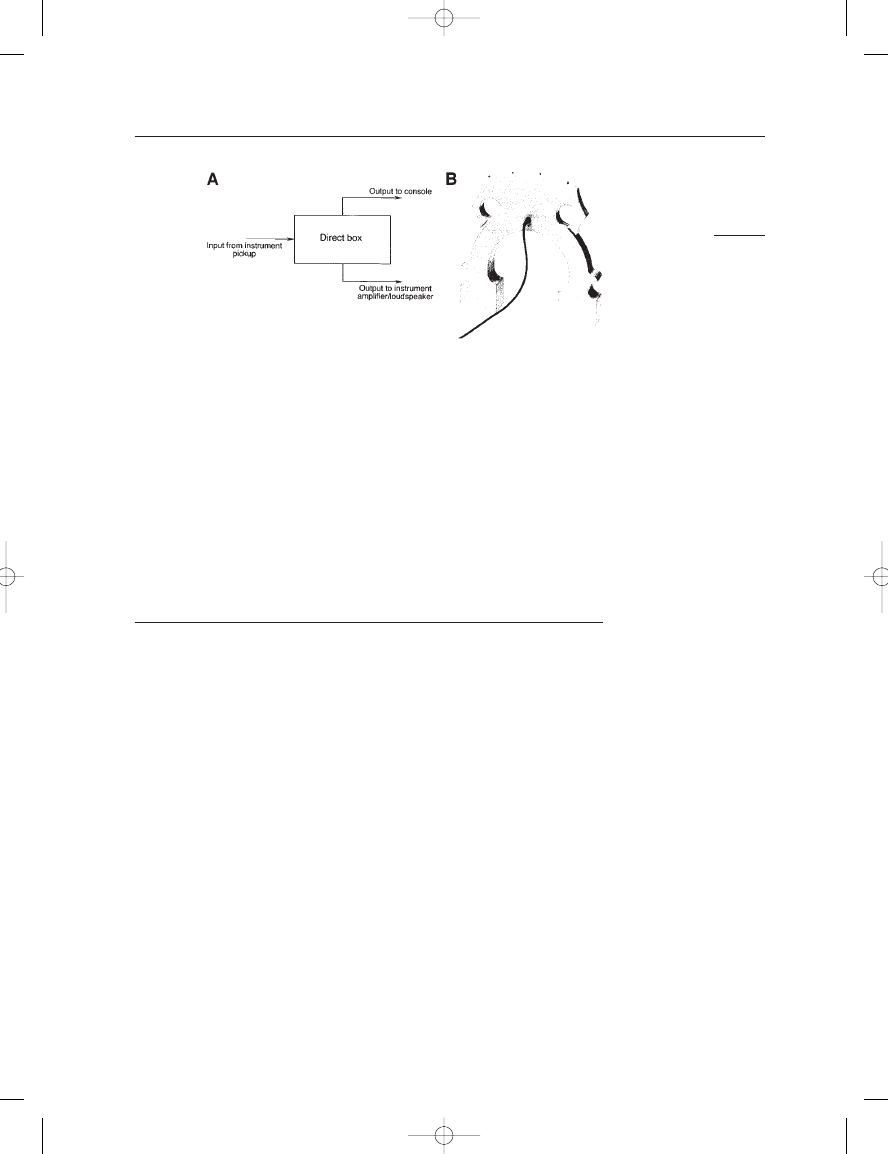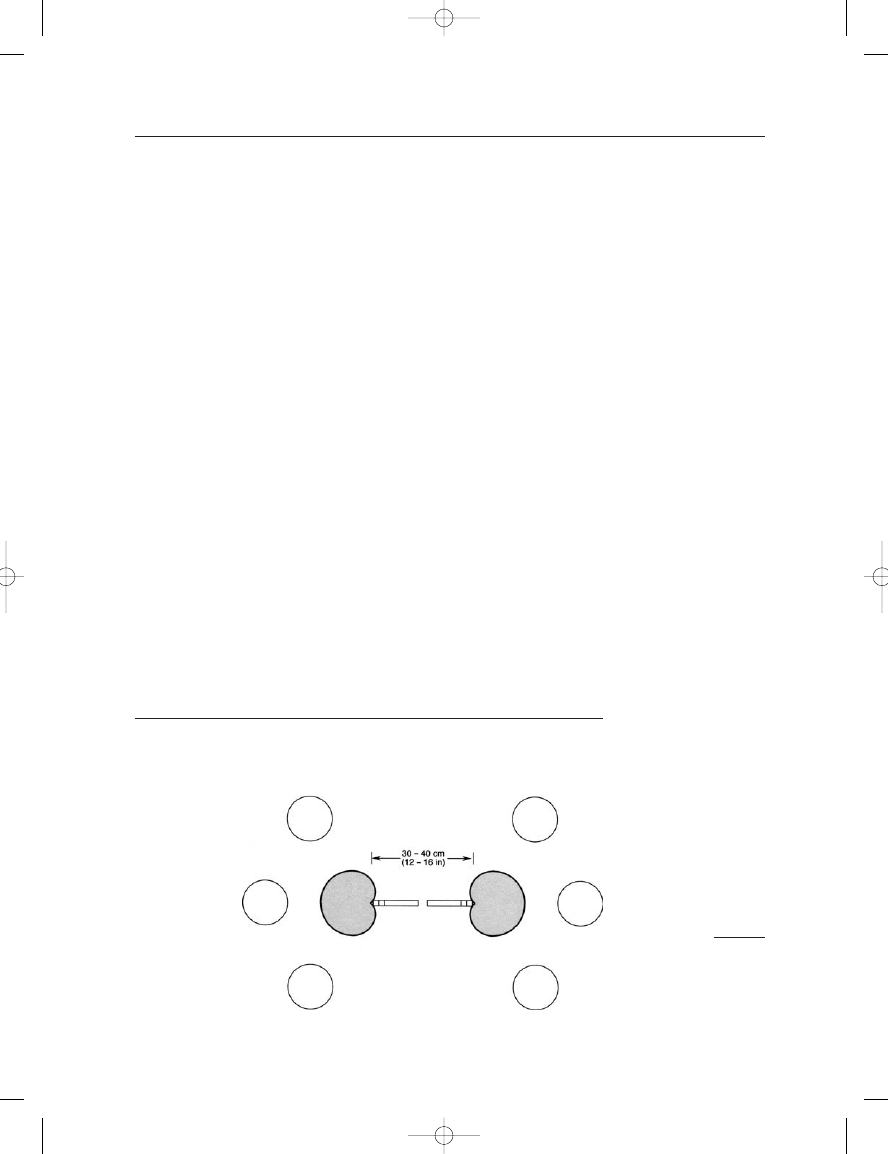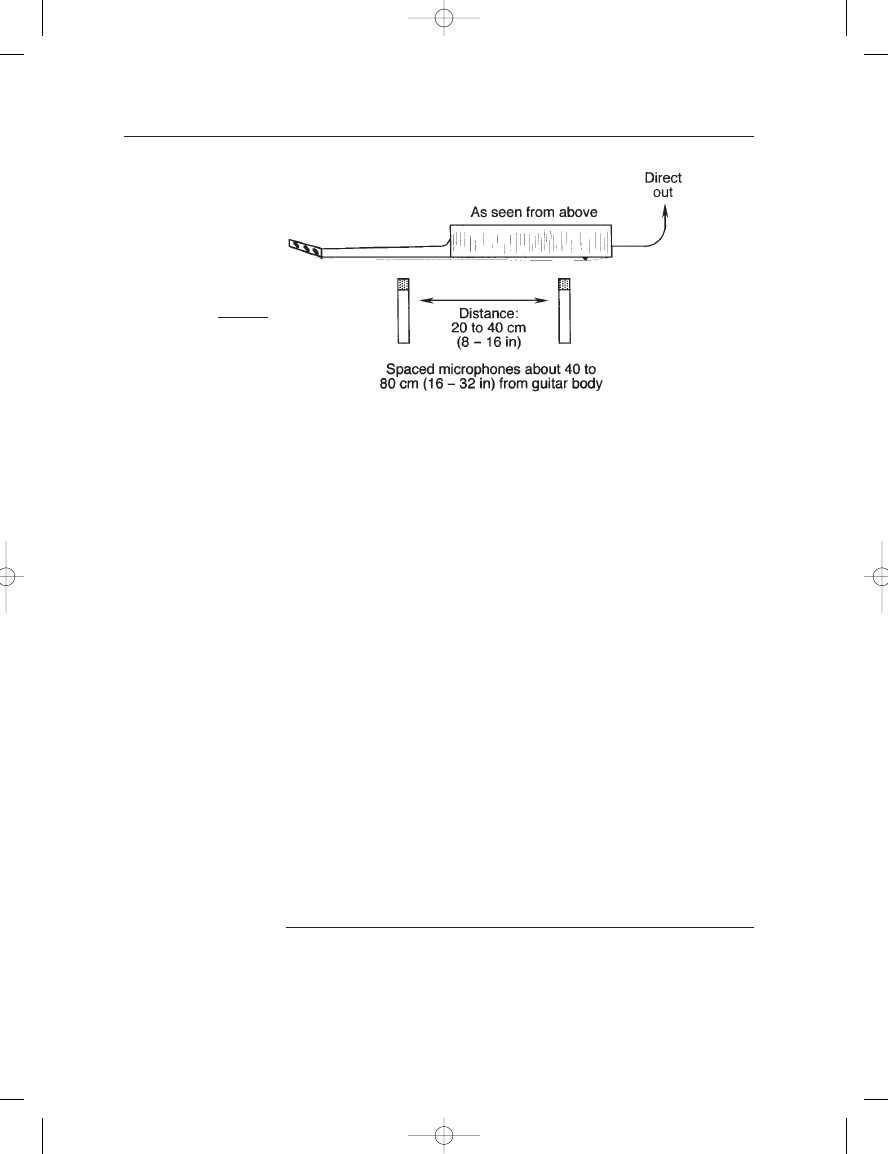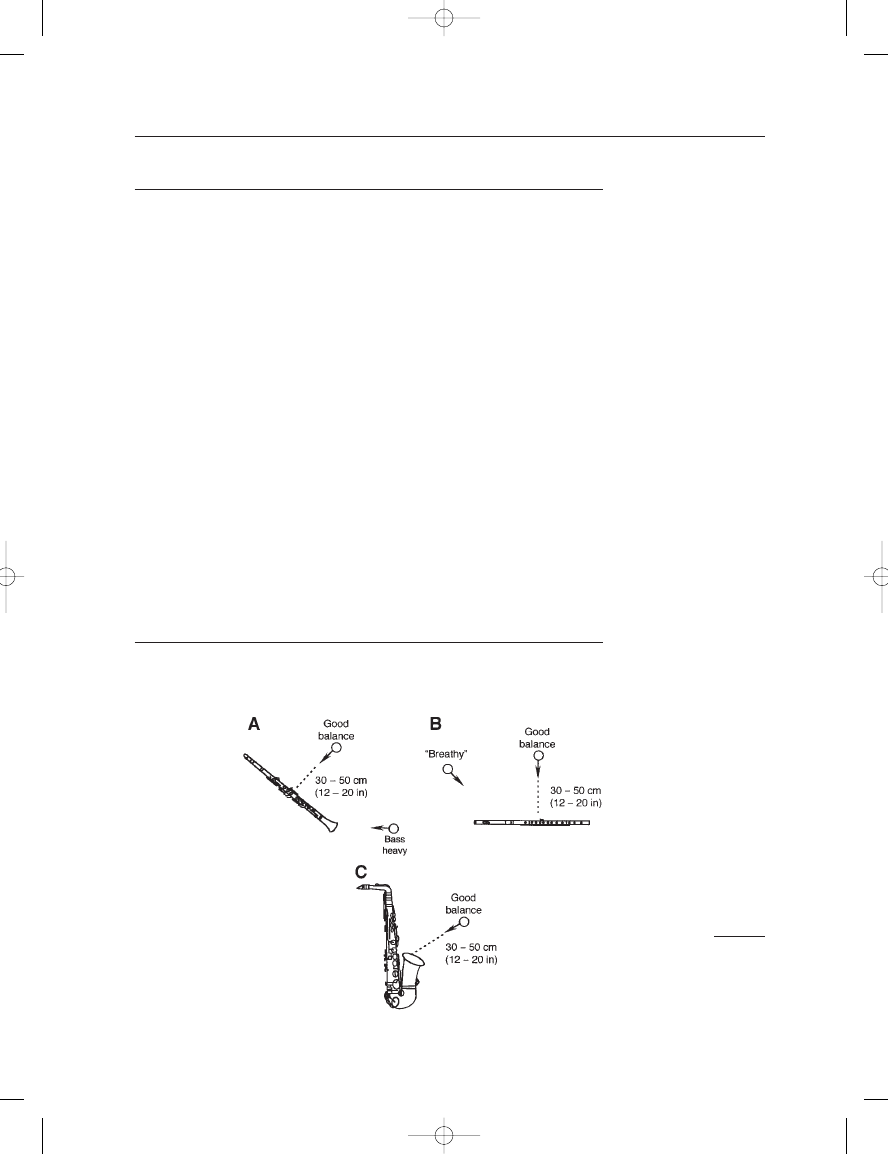ВУЗ: Казахская Национальная Академия Искусств им. Т. Жургенова
Категория: Книга
Дисциплина: Не указана
Добавлен: 03.02.2019
Просмотров: 17293
Скачиваний: 51

CHOICE OF MICROPHONES FOR BASS PICKUP
Bass tracks are invariably compressed and equalized during postpro-
duction. While much in the way of equalization can be done at that time,
it is always best to get the ideal sound on the basic tracks in the first
place. There are a number of excellent dynamic microphones for bass
pickup; these are often models that have been designed with a slight bass
rise and with adequate headroom at low frequencies. Many engineers
prefer to use large diameter Braunmühl-Weber capacitor types, since
these models often have distinctive high frequency signatures which both
engineer and performer may deem desirable.
VOCALS AND VOCAL GROUPS
In performance, most vocalists make use of handheld “vocal microphones”
whose response characteristics are internally equalized to produce a fairly
smooth response at close operating distances. In the studio, the vocalist is
normally recorded via a Braunmühl-Weber dual diaphragm large format
capacitor model. Years of acclimation have convinced most vocalists as
well as engineers that this is the only way to go.
There is much to be said in favor of this microphone type: the mod-
els are all slightly different in response, and the engineer can usually pick
one that truly enhances the performer’s voice at high frequencies. As a
group they are robust and can take high vocal levels in stride. Many
older tube models dating from the early 1960s are highly regarded and
are routinely used for these purposes. (See Chapter 21 for a discussion of
older classic microphone models.)
The normal studio setup is as shown in Figure 14–15. The micro-
phone, set in cardioid position, is placed in front and above the vocalist,
with room for a music stand. The operating distance is approximately
0.6 m (24 in). A sheer pop screen is normally positioned in front of the
microphone as shown in order to control inadvertent pops of wind from
the vocalist. Be sure to angle the music stand so that there are no direct
reflections from the vocalist to the microphone. It is customary to provide
a stool for the vocalist, whether or not it is actually used. In a tracking
THE MICROPHONE BOOK
228
FIGURE 14–14
Recording the bass: using
the direct output from the
bass (A); a pickup mounted
on the instrument’s bridge
(B). (Photo courtesy of
AKG Acoustics.)
Earg_14.qxd 14/9/04 2:55 PM Page 228

session, the vocalist will normally be surrounded by baffles on three sides,
and in extreme cases of studio leakage it may be necessary for the vocal-
ist to perform in a vocal booth. This is a rather confining environment
and should be chosen as last resort.
Wherever the vocalist is located, it is important that headphone
monitoring be carefully tailored to the vocalist’s tastes. Typically, the
vocalist will want to monitor a stereo mix with a generous amount of the
vocal track itself, complete with stereo reverberation. In the unlikely
event that you are using a compressor on the vocal track going to tape,
do not put that signal in the vocalist’s monitor mix.
There are so many important details here that it is strongly recom-
mended that you cover as many points in setup as you can before the
vocalist arrives for the session. You can always find someone on the studio
staff who will be glad to help you set up. The psychology of the moment
is critical; nothing is more comforting to a vocalist than hearing a truly
clean and clear sound the first moment the headphones are put on.
14: Studio Recording Techniques
229
FIGURE 14–15
Recording a vocalist: side
view (A); top view (B).
Earg_14.qxd 14/9/04 2:55 PM Page 229

AFTER THE INITIAL TRACKING SESSIONS
On many occasions the vocalist will want to record basic vocal tracks
after the initial instrumental tracking sessions have been finished. In this
case there will be few, if any, performers in the studio, and the isolation
measures we have discussed will probably not be necessary.
Be prepared to do vocal insert recording efficiently and smoothly, if
it is required. Make sure you have an experienced tape operator who can
keep accurate notes on the take sheets.
As vocal tracking gets underway the singer will want to come into
the control room to listen to the tracks that have just been recorded.
Make sure that you have a reasonable monitor mix up and running for
the singer and other artists as soon as they get to the control room.
While many of the points we are making here have nothing to do
with microphone technique as such, they are very important to the
smooth running of any pop recording session – and directly reflect on
your general competence and microphone choices.
RECORDING BACKUP VOCALISTS
You can use as many recording channels as you have to spare, but a
minimum of two may suffice, as shown in Figure 14–16. Since more than
one singer will be on each microphone, do not hesitate to reposition the
singers slightly in order to correct balances. Experienced backup singers
are always aware of this and will gladly follow your requests. If you find
it necessary to compress the stereo signals, make sure that you use two
compressors that are stereo-coupled in order to maintain overall balances.
A backup chorus, if needed, can best be recorded using the classical
techniques discussed in Chapter 13.
RECORDING THE GUITAR
The acoustic guitar is equally at home in classical as well as popular
music of all kinds. While intimately associated with Spain, it has become
THE MICROPHONE BOOK
230
FIGURE 14–16
Recording a backup vocal
group in stereo, top view;
circles show approximate
positions of singers.
Earg_14.qxd 14/9/04 2:55 PM Page 230

a truly universal instrument. For most of its existence it survived only as
an acoustic instrument; however, during the last five decades it has
emerged in a dual role in both acoustical and amplified form. For rock
applications, the solid body guitar has become the chief instrumental
musical element. With its solid body structure, the only resonance pres-
ent in the instrument lies in the strings, and the sound we hear is that of
the strings alone suitably amplified and processed.
In the studio, the acoustical guitar is normally recorded both with
microphones and via direct electrical output; in many cases a final mix will
make use of both inputs. In this section we will consider both options.
Figure 14–17 shows a conventional stereo method for recording the
guitar acoustically. Most engineers prefer spaced microphones as shown
here, but a coincident pair of cardioids is also an option.
When using spaced microphones, if the guitar is to appear in mono
in subsequent postproduction, it is best if only one of the recorded chan-
nels is used, suitably equalizing it for the desired spectral balance.
Alternatively, a coincident pair can be mixed directly to mono with no
phase cancellation problems.
There is much added flexibility in postproduction if a third track is
used to record the direct output from the guitar. The timbral difference
between the direct and microphone signals will be considerable, and this
can be used to create a fairly widely spaced stereo presentation.
Modern guitar amplifiers have stereo outputs, and when recording
the solid body instrument it would be a mistake not to record both out-
puts for the maximum postproduction flexibility.
SYNTHESIZERS
Like the solid body guitar, the synthesizer (“synth”, as it is called) can
only be recorded directly from a stereo pair of outputs. In many cases
synth players will want to lay down additional tracks by overdubbing,
so manage your track capability accordingly.
14: Studio Recording Techniques
231
FIGURE 14–17
Recording the acoustical
guitar with microphones
and direct input to the
console.
Earg_14.qxd 14/9/04 2:55 PM Page 231

WOODWIND AND BRASS INSTRUMENTS
As noted in Chapter 13, woodwind instruments have fairly complicated
radiation patterns, and this dictates that microphones should not be
placed too close to them if a balanced sound is desired. Often on televi-
sion performances we often see small microphones clipped to the bells of
clarinets, primarily as a matter of expedience. If Figure 13-2 is any indi-
cator, the resulting sound is likely to be very bass heavy, and consider-
able equalization will be needed to create a good timbre. Brass
instruments will fare somewhat better with such close pickup, since all
radiation is by way of the bell. Figures 14–18 and 14–19, respectively,
show how individual woodwind and brass instruments may be recorded
close-in for best balance. The dimensions shown in Figures 14–18 and
14–19 represent minimum values; you can always place the microphone
farther away, consistent with leakage problems in the studio. See Meyer
(1978), Dickreiter (1989) and Eargle (1995) for additional information
on the directional characteristics of musical instruments.
The French horn is a special case. It is normally heard via room
reflections, since the bell always fires to the rear of the player. If more
control is needed it is best to place a microphone oriented overhead at
90
to the bell axis. In that position the microphone will pick up some of
the “buzz” that characterizes the raw sound of the instrument, giving the
recorded sound additional presence. Whenever possible, a set of reflec-
tive baffles should be placed behind the instruments.
STRING INSTRUMENTS
Data given in Figure 13–3 show the complex nature of radiation from
bowed string instruments, indicating how difficult it is to obtain a natural
THE MICROPHONE BOOK
232
FIGURE 14–18
Recording woodwind
instruments: flute
(A); oboe/clarinet (B);
saxophone (C).
Earg_14.qxd 14/9/04 2:55 PM Page 232